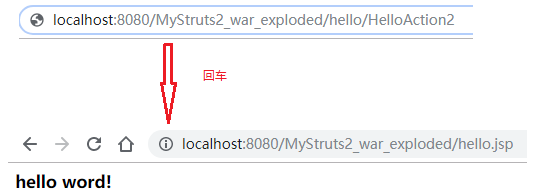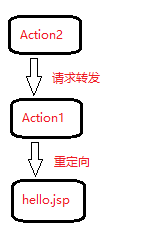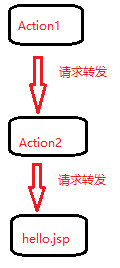1、配置流程
(1)web.xml文件(在web目录下的WEB-INF目录里面):对过滤器进行配置(这里是统一的)
<?xml version="1.0" encoding="UTF-8"?>
<web-app xmlns="http://xmlns.jcp.org/xml/ns/javaee"
xmlns:xsi="http://www.w3.org/2001/XMLSchema-instance"
xsi:schemaLocation="http://xmlns.jcp.org/xml/ns/javaee http://xmlns.jcp.org/xml/ns/javaee/web-app_4_0.xsd"
version="4.0">
<filter>
<filter-name>struts2</filter-name><!--不重复即可-->
<filter-class>org.apache.struts2.dispatcher.ng.filter.StrutsPrepareAndExecuteFilter</filter-class><!--过滤器类名-->
</filter>
<filter-mapping>
<filter-name>struts2</filter-name>
<url-pattern>/*</url-pattern>
</filter-mapping>
</web-app>
(2)页面部分:用于测试是否能访问到目标页面
<%@ page contentType="text/html;charset=UTF-8" language="java" %>
<html>
<head>
<title>hello</title>
</head>
<body>
<h3>hello word!</h3>
</body>
</html>
(3)struts.xml:在src目录下
(4)书写Action类:这里统一采用继承ActionSupport类的方式创建Action类
2、请求转发(默认方式)
(1)struts.xml文件配置:
<?xml version="1.0" encoding="UTF-8"?>
<!DOCTYPE struts PUBLIC
"-//Apache Software Foundation//DTD Struts Configuration 2.0//EN"
"http://struts.apache.org/dtds/struts-2.0.dtd">
<struts>
<package name="hello" namespace="/hello" extends="struts-default">
<action name="HelloAction" class="pers.zhb.hello.HelloAction" method="execute">
<result name="success" type="dispatcher">/hello.jsp</result>
</action>
</package>
</struts>
result标签内部的属性被定义为请求转发的方式,请求转发为默认的访问方式,即使不配置该属性依旧以请求转发的方式访问hello.jsp
(2)Action类
public class HelloAction extends ActionSupport {
public String execute() {
return "success";
}
}
(3)测试结果

3、重定向
(1)struts.xml配置文件
<struts>
<package name="hello" namespace="/hello" extends="struts-default">
<action name="HelloAction" class="pers.zhb.hello.HelloAction" method="execute">
<result name="success" type="redirect">/hello.jsp</result>
</action>
</package>
</struts>
(2)测试结果:

4、从一个Action请求转发到另外一个Action
(1)struts.xml配置文件:
<struts>
<package name="hello" namespace="/hello" extends="struts-default">
<action name="HelloAction1" class="pers.zhb.hello.HelloAction1" method="execute">
<result name="success" type="redirect">/hello.jsp</result>
</action>
<action name="HelloAction2" class="pers.zhb.hello.HelloAction2" method="execute">
<result name="success" type="chain">
<param name="actionName">HelloAction1</param>
<param name="namespace">/hello</param>
</result>
</action>
</package>
</struts>
其中package和param中的namespace属性的指定的值要保持一致,第一个param中的值为要请求转发到的Action的名称。
(2)创建两个Action:
Action1:
public class HelloAction1 extends ActionSupport {
public String execute() {
System.out.println("我是HelloAction1!");
return "success";
}
}
Action2:
public class HelloAction2 extends ActionSupport {
public String execute() {
System.out.println("我是HelloAction2!");
return "success";
}
}
(3)测试结果:
浏览器:

控制台:

(4)运行流程

5、从一个Action重定向到另外一个Action
(1)struts.xml配置文件:
<struts>
<package name="hello" namespace="/hello" extends="struts-default">
<action name="HelloAction1" class="pers.zhb.hello.HelloAction1" method="execute">
<result name="success" type="dispatcher">/hello.jsp</result>
</action>
<action name="HelloAction2" class="pers.zhb.hello.HelloAction2" method="execute">
<result name="success" type="redirectAction">
<param name="actionName">HelloAction1</param>
<param name="namespace">/hello</param>
</result>
</action>
</package>
</struts>
(2)创建两个Action
(3)测试结果:

(4)访问流程:
